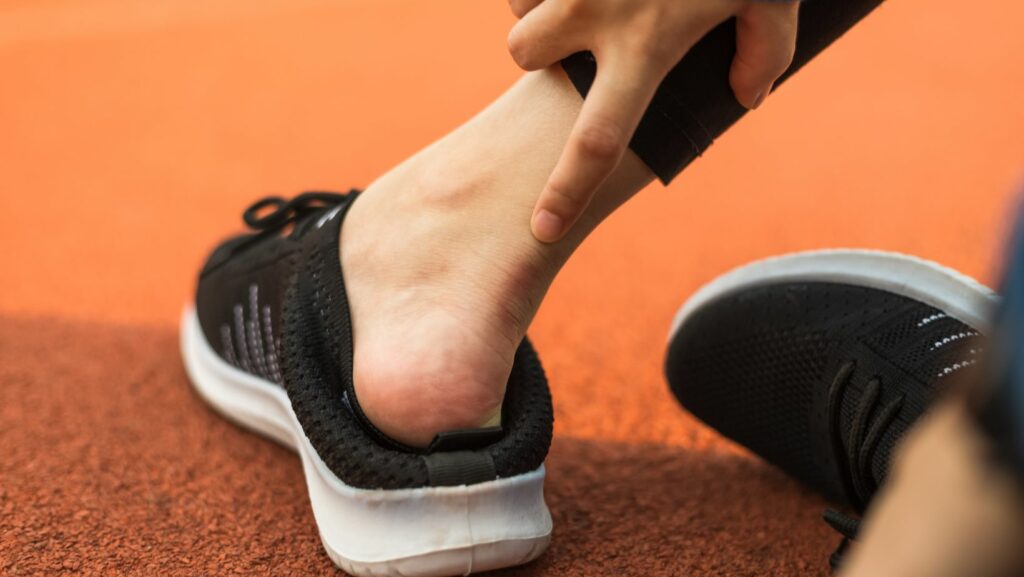Every runner knows the thrill of hitting the pavement, but what happens when that exhilarating stride turns into a painful heel throb? It’s like your foot’s way of saying, “Hey, remember me? I’m not just here for the ride!” Whether you’re training for a marathon or just jogging to escape the daily grind, heel pain can be a sneaky saboteur.
Why Does My Heel Hurt After Running
Heel pain after running can stem from several conditions. Understanding these causes helps athletes take preventive measures.
Plantar Fasciitis

Plantar fasciitis involves inflammation of the plantar fascia, a thick band of tissue connecting the heel to the front of the foot. Pain often occurs at the bottom of the heel, especially after periods of rest. Many runners experience heightened discomfort during the first few steps in the morning. Factors contributing to this condition include improper footwear, excessive mileage, and flat feet or high arches. Stretching exercises and supportive shoes can alleviate symptoms and promote healing.
Achilles Tendonitis
Achilles tendonitis affects the Achilles tendon, linking the calf muscles to the heel. This condition manifests as pain above the heel, particularly during running or walking. Symptoms may intensify with increased activity levels. Runners often encounter this issue due to tight calf muscles or inadequate warm-up routines. Reducing mileage and incorporating stretching and strengthening exercises can enhance flexibility and support tendon recovery.
Heel Spurs
Heel spurs are bony protrusions that develop on the underside of the heel bone. Often associated with plantar fasciitis, these spurs can create sharp, stabbing pain in the heel, especially during movement. Many individuals notice discomfort after standing or walking for extended periods. Factors like obesity, poor footwear, and repetitive stress from running contribute to heel spur formation. Treatment options include stretching, physical therapy, and ice application to manage inflammation and reduce pain.
Symptoms to Watch For
Heel pain after running often presents specific symptoms that runners should monitor closely to avoid long-term complications. Recognizing these signs plays a key role in maintaining foot health.
Sharp Pain
Experiencing sharp pain in the heel can signal several underlying issues. Runners commonly report this feeling after standing or walking for extended periods. Such pain tends to intensify with each step taken during runs, particularly in the morning or after periods of rest. Identifying sharp pain early helps manage conditions like plantar fasciitis or heel spurs. Sharp, sudden discomfort can also indicate Achilles tendonitis. Immediate attention to sharp pain often prevents worsening conditions that could hinder running performance.
Stiffness
Feeling stiffness in the heel after running may indicate inflammation or irritation. Many runners notice this symptom right after waking or following periods of inactivity. Stiffness typically limits mobility, making it difficult to engage in regular running activities. Often, this sensation improves with movement but can return after extended rest. Noticing persistent stiffness may suggest underlying issues like Achilles tendonitis or plantar fasciitis. Addressing stiffness promptly can facilitate recovery and improve overall running experience.
Prevention Tips
Heel pain can often be managed with simple practices. Implementing preventative measures helps runners maintain foot health and enjoy their activities.
Proper Footwear
Choosing suitable footwear is essential for preventing heel pain. Supportive running shoes provide the necessary cushioning for the heel and arch, addressing issues like plantar fasciitis. Selecting shoes that fit well reduces friction and pressure on the heel. Runners should consider shoes designed for their foot type, whether flat, neutral, or high-arched. Regularly replacing worn-out shoes ensures optimal support, as cushioning diminishes over time. Additionally, visiting a specialist for gait analysis can offer insights into the appropriate footwear needed.
Warm-Up and Stretching
Incorporating warm-up exercises prepares the body for running. Dynamic stretches targeting the calves and Achilles tendon increase flexibility and circulation before running. Performing exercises such as calf raises and ankle rolls can enhance strength and mobility in the feet. Post-run static stretching alleviates tightness, particularly in the calf muscles. Holding stretches for at least 30 seconds promotes muscle recovery and reduces stiffness in the heel. Establishing a consistent warm-up and cool-down routine contributes to overall foot health and minimizes the risk of injury.
Treatment Options
Managing heel pain effectively requires a multi-faceted approach. Several treatment options exist to alleviate discomfort and support recovery.
Rest and Ice
Rest and ice play crucial roles in healing heel pain. Taking breaks from running allows the body to recover and reduces inflammation. Applying ice to the affected area for 15 to 20 minutes can significantly minimize swelling. He or she should repeat this several times a day for optimal results. Elevating the foot during rest aids in decreasing pain and promotes blood flow to the heel. This simple combination of rest and ice often provides immediate relief, making it a foundational strategy for runners facing heel issues.
Physical Therapy

Physical therapy offers targeted exercises for strength and flexibility. A qualified physical therapist evaluates the specific conditions causing heel pain and develops a personalized treatment plan. Stretching exercises for the calves and plantar fascia improve range of motion and help alleviate tension. Strengthening activities, such as toe raises and calf raises, bolster the muscles supporting the foot. Consistent sessions enhance recovery and reduce the risk of future injuries. Ultimately, physical therapy focuses on functional movements, providing runners with the tools to maintain their running routines without discomfort.
Enjoyable Running Experience
Heel pain after running can be a frustrating barrier for many athletes. Understanding the underlying causes is essential for effective management and prevention. By recognizing symptoms early and addressing them with proper footwear and stretching routines, runners can significantly reduce discomfort.
Incorporating rest and ice into recovery strategies can further aid healing. Seeking professional guidance from a physical therapist can also provide tailored exercises to strengthen the foot and improve flexibility. Prioritizing foot health not only enhances performance but also ensures a more enjoyable running experience.
 Plantar fasciitis involves inflammation of the plantar fascia, a thick band of tissue connecting the heel to the front of the foot. Pain often occurs at the bottom of the heel, especially after periods of rest. Many runners experience heightened discomfort during the first few steps in the morning. Factors contributing to this condition include improper footwear, excessive mileage, and flat feet or high arches. Stretching exercises and supportive shoes can alleviate symptoms and promote healing.
Plantar fasciitis involves inflammation of the plantar fascia, a thick band of tissue connecting the heel to the front of the foot. Pain often occurs at the bottom of the heel, especially after periods of rest. Many runners experience heightened discomfort during the first few steps in the morning. Factors contributing to this condition include improper footwear, excessive mileage, and flat feet or high arches. Stretching exercises and supportive shoes can alleviate symptoms and promote healing.
 Physical therapy offers targeted exercises for strength and flexibility. A qualified physical therapist evaluates the specific conditions causing heel pain and develops a personalized treatment plan. Stretching exercises for the calves and plantar fascia improve range of motion and help alleviate tension. Strengthening activities, such as toe raises and calf raises, bolster the muscles supporting the foot. Consistent sessions enhance recovery and reduce the risk of future injuries. Ultimately, physical therapy focuses on functional movements, providing runners with the tools to maintain their running routines without discomfort.
Physical therapy offers targeted exercises for strength and flexibility. A qualified physical therapist evaluates the specific conditions causing heel pain and develops a personalized treatment plan. Stretching exercises for the calves and plantar fascia improve range of motion and help alleviate tension. Strengthening activities, such as toe raises and calf raises, bolster the muscles supporting the foot. Consistent sessions enhance recovery and reduce the risk of future injuries. Ultimately, physical therapy focuses on functional movements, providing runners with the tools to maintain their running routines without discomfort.

